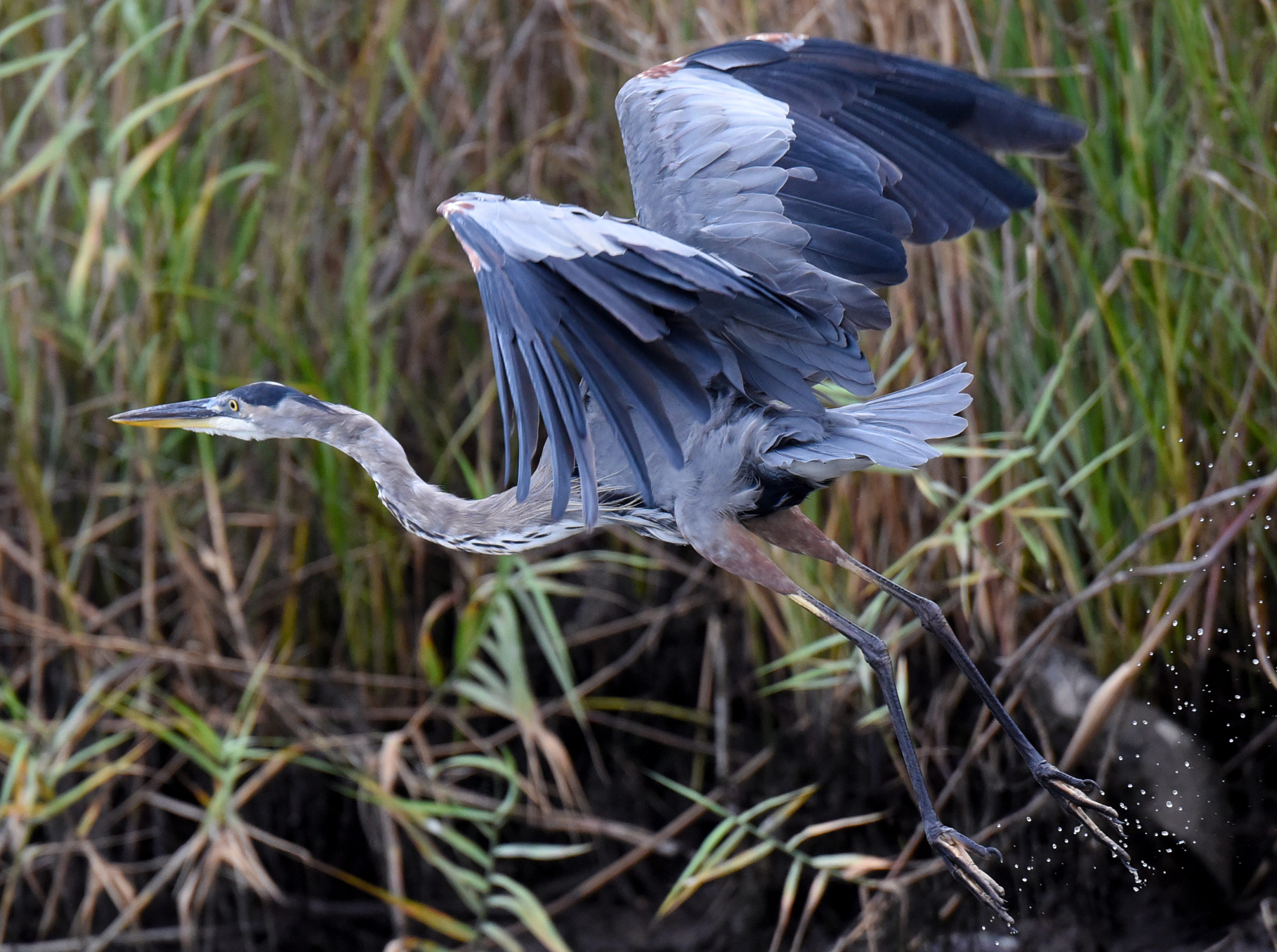
This article is from the summer edition of Mobile Baykeeper’s print quarterly, CURRENTS. The magazine is mailed to active members who have given more than $50 in 2023. To get on the magazine’s mailing list, donate here.
text and photos by Susan Rouillier
In the realm of avian elegance, few creatures rival the grandeur and grace of the Great blue heron. Standing tall with regal poise, these magnificent birds can be seen around our Bay and rivers as they patrol the shallows and wetlands with precision. With their distinctive features, hunting techniques, and solitary nature, great blue herons have carved a niche in the bird kingdom, captivating the hearts and minds of observers not only in Alabama, but also in their worldwide distribution.
Twelve Herons in Alabama
Of the 17 species of long-legged, long-necked coastal birds in the family Ardeidae, 12 can be found in Alabama: Green heron, Black-crowned night heron, Yellow-crowned night heron, Tri-colored heron, Reddish egret, Cattle egret, Great egret, Snowy egret, Little blue heron, American bittern, Least bittern, and the Great blue heron. They are water-loving birds found in saltwater, freshwater, or even your backyard pond as they peer in for a quick snack.
Sweet Scientific Name
In 1758, the renowned scientist Carl Linnaeus bestowed the name “Ardea herodias” upon the majestic GBH. Derived from the Greek language, “Ardea” signifies “heron,” while “herodias” translates to “to watch over.”
Not So Ancient
The GBHs would not have heard any dinosaur sounds nor seen these creatures either. The oldest record of a GBH is only 1.8 million years old, and dinosaurs became extinct about 65 million years ago.
Physical Appearance
The GBH is Alabama’s largest heron, and also the largest heron in the United States, standing at a height of almost five feet, with an impressive 6-foot wingspan. These statuesque birds are second only in height to the Sandhill crane. Its long, slender neck seamlessly blends with its elongated body, exuding an air of elegance and grace. The most striking characteristic of the GBH is its plumage, which is a fusion of shades ranging from blue-gray to slate, with accents of chestnut and black. Its feathers possess a velvety texture, almost appearing as if they were painted with a fine brushstroke. It has long, feather plumes on its head, neck, and back. Its bill, eyes, and legs are orange-yellow.
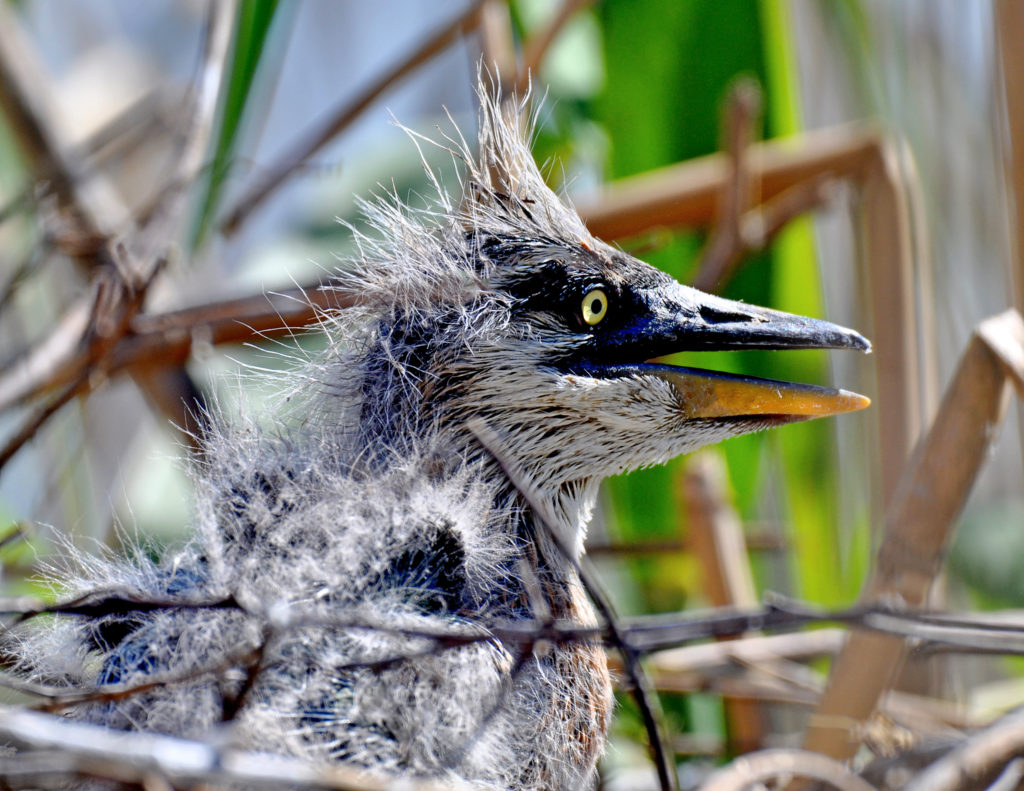
Flying Speed
The GBH flies with slow, steady beats at the respectable speed of 30 miles per hour. In flight, its neck is retracted into an S-shape, characteristic of other herons but unlike storks, cranes, and flamingos that fly with a straight neck.
Clever Grooming Traits
GBHs have built-in adaptations to help them keep clean, which is something important for a creature with a mostly fishy diet. Its chest plumes fray into a powder at the ends allowing it to slough off fish slime. It also has a modified claw that can scrape off debris from its chest feathers.
Viva La Difference
Great blue herons exhibit sexual dimorphism — male GBHs are larger than the females. Females tend to weigh between four and a half to six pounds while males are heavier at six to eight pounds. Males are also longer than females and can be up to 54 inches long, while females are approximately 36 to 40 inches. The size of their bills also differs — with males having a slightly longer bill than females.
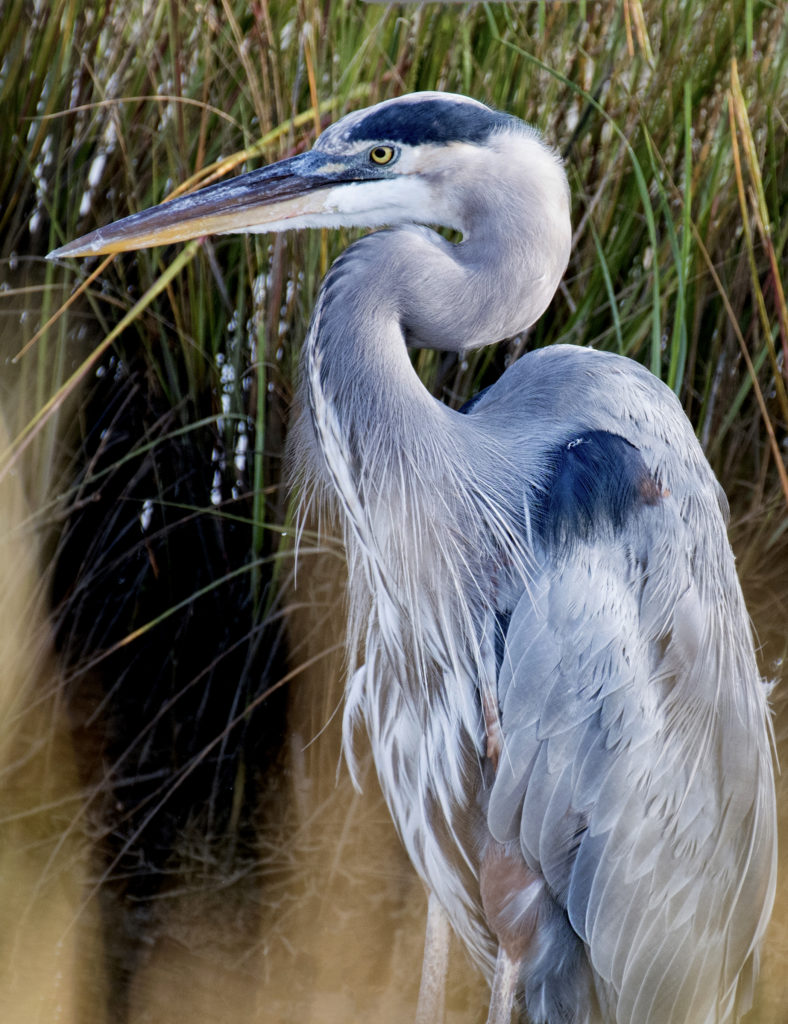
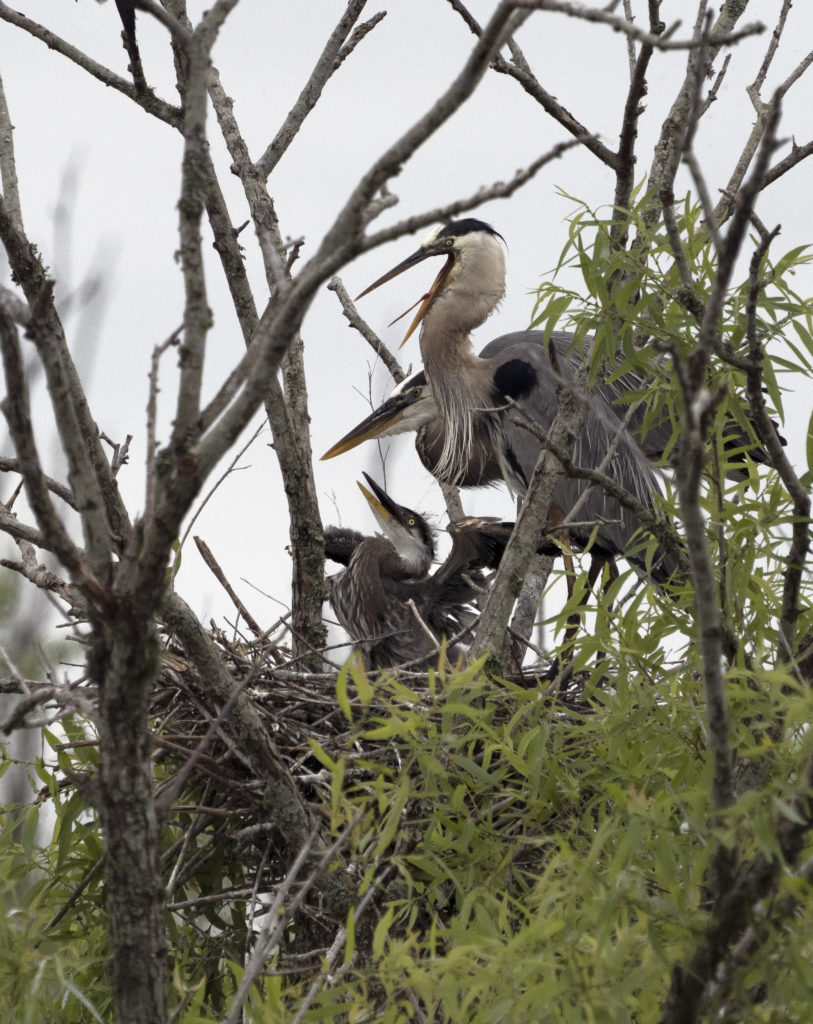
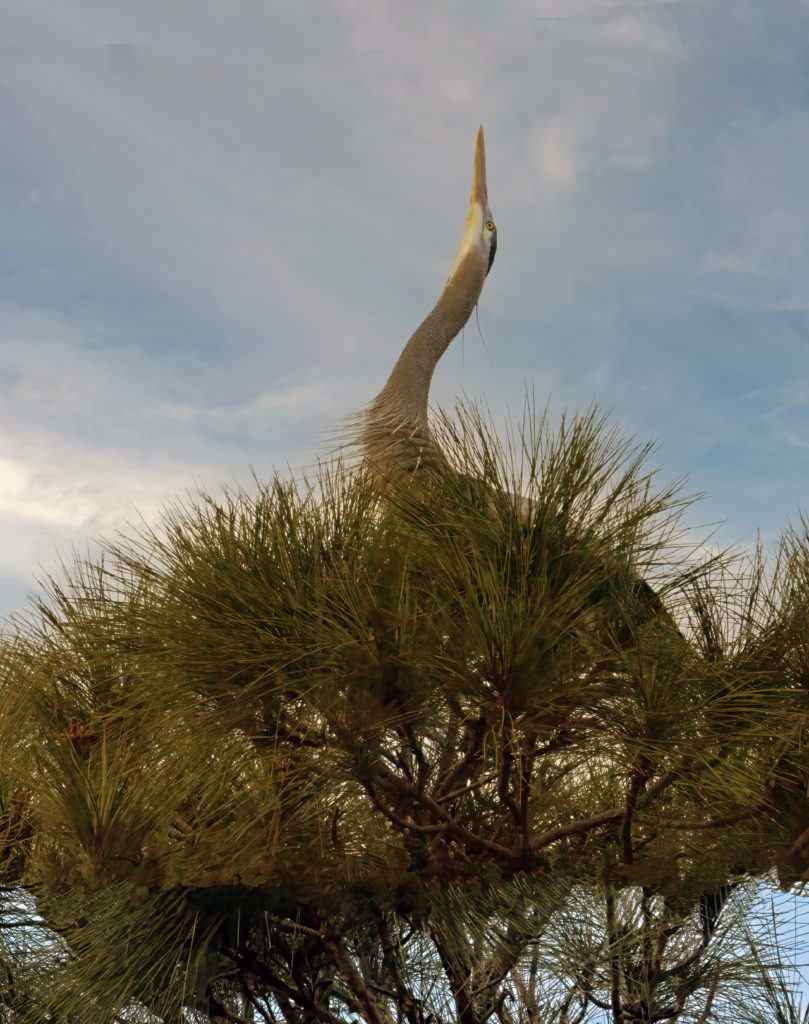
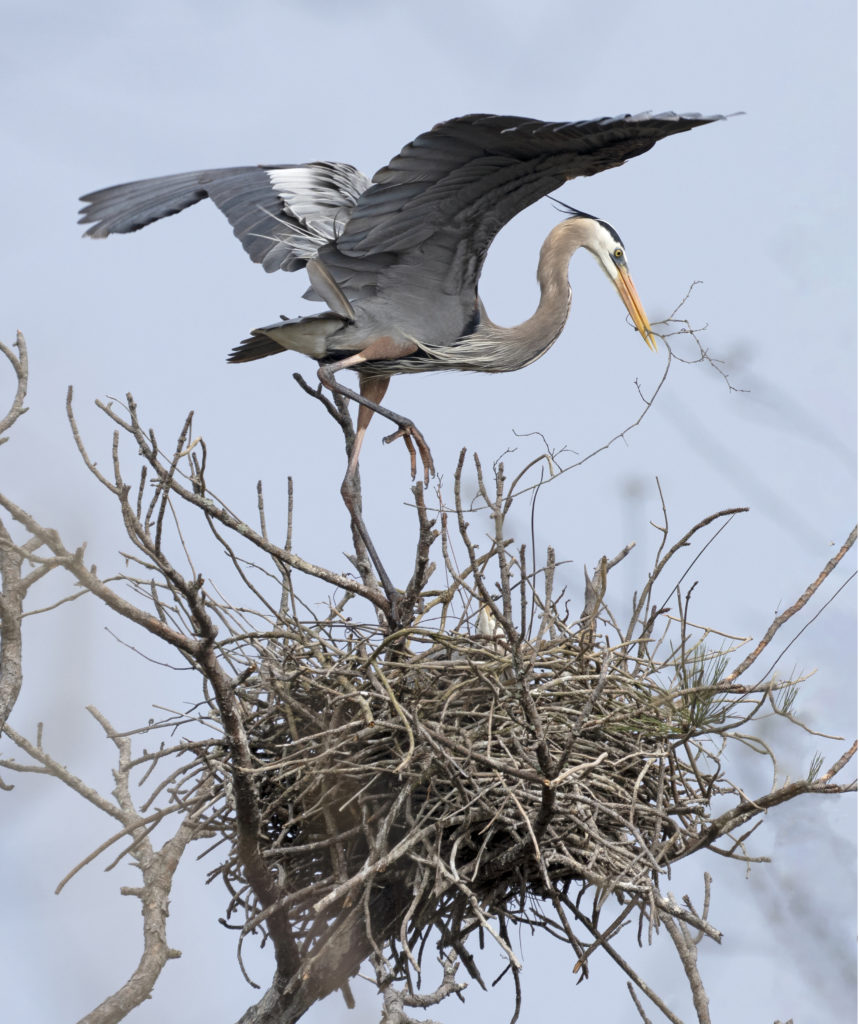
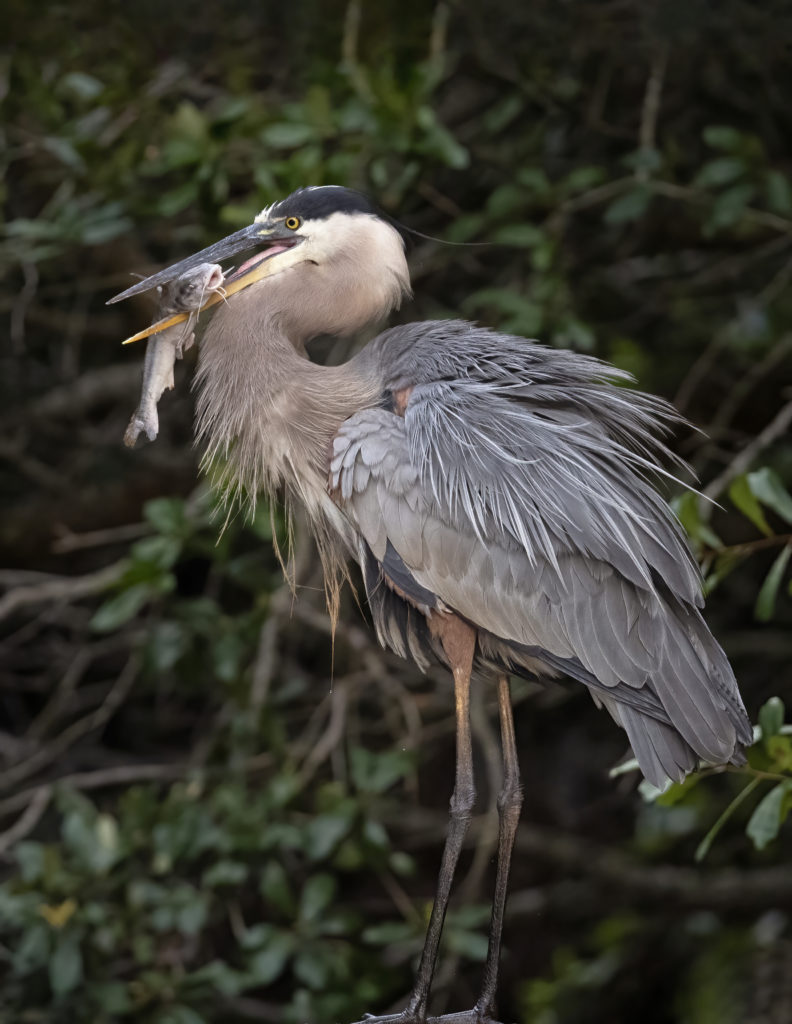
Amazing Hunting Techniques
The GBH exhibits a cautious and deliberate approach to hunting. With slow, measured steps, it traverses the shallows, its long legs moving with ballet precision, barely disturbing the tranquil surface of the water. It also adopts a patient stance, standing motionless as a sentinel, head hunched upon its shoulders, keenly observing the aquatic world beneath. Once a suitable target is spotted, the Great blue heron deploys an incredibly swift and powerful strike to impale its prey, then swallows it whole. If it is a catfish, they will toss it and swallow it headfirst to protect their neck from fish spines. While its primary diet consists of fish, these opportunistic predators are not averse to diversifying their culinary choices. Frogs, crayfish, water snakes, mice, a variety of insects, and even small alligators fall within their diet.
Nocturnal Foraging and a Moonlit Serenade
Because a GBH’s eyesight is three times that of humans, its hunting extends beyond the boundaries of daylight. Under the cloak of darkness, these avian wonders embark on nocturnal foraging expeditions. Bathed in the soft glow of the moon, they skillfully navigate the shadowy realms. While hunting in the moonlight, the typically taciturn Great blue heron occasionally punctuates the silence with a resounding squawk, echoing through the night. By capitalizing on the abundance of food sources available under cover of darkness, these majestic creatures demonstrate their ability to thrive in diverse environments.
Big Changes in Spring
Great blue herons are known for their inherent solitude and navigate their watery domains with an air of self-sufficiency. However, during the breeding season, which typically occurs in late April and May, they experience a temporary shift in behavior. Males engage in elaborate courtship displays, showcasing their prowess through majestic flights and complex dance rituals. These performances serve to attract potential mates, and lead to the formation of temporary breeding colonies. Their appearance changes as well: both males and females grow “mating plumage,” longer plumes, and an intense blue lore (the area in front of the eye), along with bright yellow legs. The female’s legs are less bright.
Serial Monogamists
One of the most important aspects of a Great blue heron’s life — and to the survival of the species — is the choosing of a mate. Unlike many other birds, Great blue herons do not mate for life. Instead, they form a monogamous pair that remains together for the breeding season and then choose new mates the following year. To choose a mate, Great blue herons undertake a courtship ritual. However, the roles of the males and females are very different.
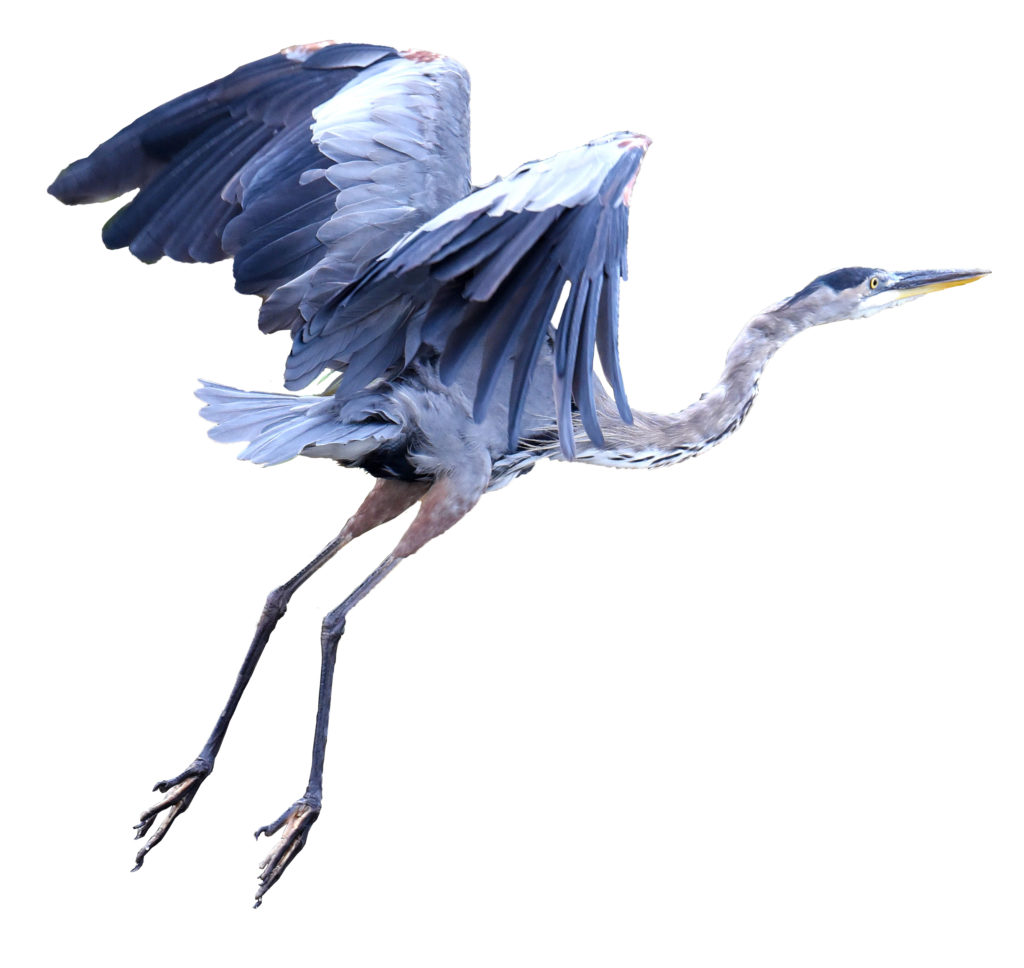
Male vs Female: Mating Behavior
Great blue herons often nest in colonies, and the males usually arrive at the nesting grounds before the females to choose a suitable nest location. They then fly in huge circles above the nesting grounds while calling to the females to woo them. During this circular flight, the males use extremely slow wing-beats and fly with their necks fully extended. Fights sometimes break out between the males as they compete for the attention of the females, but these fights are rarely ever fatal.
While the males are doing their utmost to show themselves off as the most suitable mate, fe- males arrive at the nesting site and sit until the right mate presents himself. The male continues to woo the female and will raise and stretch his head up to the sky as he calls to the females, a most beautiful sight. Their mating calls are not the usual “gwualk” sound that you hear from a GBH, but something more deep, haunting, and primordial. You can see these behaviors on Dauphin Island every spring in the tallest pine trees.
Nesting
As part of the courtship ritual, the roles of the males and females during the nesting process are very different. Once the male and female have successfully bonded, the male then selects the materials needed to build the nest and brings them to the female. Quite often, he presents the twigs and leaves to the female with a performance. This includes dropping them in front of her while shrieking, as though he is proud of himself. Once the male provides the female with the materials needed, it is time for the female to work. The female GBHs take sole responsibility for building the nest (or repairing it if it’s an old one). Nests can take up to a week to build, which is not surprising because they are large. GBH nests are usually around two feet wide when they are first built but can eventually end up three- to four-feet wide and equally as deep. Nests are built out of twigs but then lined with leaves, moss, and other plant materials.
Baby to Adult
The female lays a clutch of four to six pale-blue eggs, and both parents take turns incubating them. The parents will turn the eggs gently with their beaks during incubation. The eggs take around 25 to 30 days to hatch, although they don’t all hatch at the same time. Instead, they hatch over a period of several days, with the first chick born being the strongest. Once the eggs hatch, the colony becomes a flurry of activity as both parents tirelessly forage to quench the insatiable appetites of their ravenous and bossy chicks. The firstborn also grows the fastest and is the most aggressive in begging and acquiring food, but not all the chicks make it to the fledgling stage. As the fledglings mature and gain strength, they leave the nest, embarking on their own solitary journeys. It takes about 60 days for the chicks to go from egg to fledgling. GBHs reach sexual maturity in about three years and can live in the wild for about 15 years.
What the Babies Eat
Baby blue herons eat regurgitated food given to them by both parents. Generally, the adults will perch on the edge of the nest and feed their chicks by dropping food into their mouths. Occasionally, the chicks will pick up regurgitated food dropped into the nest. The chicks start taking whole food directly from their parents about 30 days after hatching. Small fish are the primary food items adult blue herons bring to their chicks. They also eat crabs, crayfish, tadpoles, frogs, turtles, snakes, lizards, spiders, grasshoppers, and other insects.
GBH in Native American Culture
Great blue heron symbolism in Native American culture includes good luck and prosperity, particularly because they are associated with bountiful fishing. Generally, where there are Great blue herons, local hunters can find fish. In addition, for the Cherokee and other tribes, the heron symbolizes harmony, peace, and stability. The slender, elongated legs of the heron illustrate that stability does not require imposing pillars but rather the ability to stand independently.
Endangerment
While many bird species are in decline, the Great blue heron is listed as one of “least concern” due to its generally large range and large population. The only major threat to all blue herons in general is nest disturbance.
Herons and Art
Because of their graceful and statuesque appearance, GBHs are featured in many artworks. An internet search revealed that an original Audubon aquatint, with original hand coloring engraved by Robert Havell (1793- 1878), is for sale for $90,000.
Photographer’s Delight
If you want to photograph birds, the GBH is a great one to start with because it is large, and it moves very slowly. But if you want to clearly capture its lightning-fast, spear-fishing strike with its dagger-like beak, be sure to use your highest shutter speed.
Where to See GBHs Locally
You can find GBHs foraging or flying along both the eastern and western shores of Mobile Bay, by rivers in the Mobile-Tensaw Delta, in Mobile’s Langan Park, on Dog River and its tributaries, in many wetlands, and on Dauphin Island. In the spring, look for them nesting in the tallest pine trees on Bienville Boulevard, or the pines on the north side of the entrance to the Dauphin Island Ferry. You can count on seeing at least one GBH in the tidal pools and beaches just east of the Dauphin Island Pier.
The Great blue heron is an awe-inspiring bird. Its majestic presence, elegant hunting techniques, and solitary nature have captivated the imagination of nature enthusiasts and birdwatchers everywhere. From the tranquility of their watery realms to their moonlit serenades that resonate through the night, this bird is a symbol of grace, resilience, and adaptability.
Susan Rouillier lives on Mobile Bay where she photographs and paints images of birds and wildlife. She is the author of two poetry/ image books (South Mobile Birds and South Mobile Wildlife), as well as South Mobile 1699-2018, a history of our region, all available on Amazon. You can find her work on Instagram, Facebook, and at Susierou.com.
